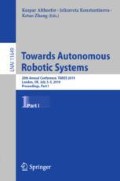Abstract
With the rise of Virtual Reality (VR) applications it is interesting to see how immersion can be improved, especially by providing haptic feedback on the user hands, using affordable technologies. Indeed, while several commercial products exist that can be used as input devices (i.e. from the user to the virtual reality), such as data gloves or optical trackers, solutions for effective feedback (i.e. from the virtual reality to the user) are still lacking, especially at low prices. We describe here the design and realization of an affordable data glove to provide vibrotactile feedback to human users using small vibrating motors, and we report preliminary user studies to prove its effectiveness; interestingly, combined with a commercially available optical tracker (i.e. Leap Motion) to be used as input device, the data glove can be used in a wide range of Virtual Reality and Telerobotics applications. User studies include (i) rendering a feedback to multiple fingers at the same time, and recording how many stimuli the users could correctly differentiate, and (ii) simulating the stiffness of a virtual object, and testing through a Just Noticeable Difference (JND) experiment whether participants could differentiate two objects chosen among 20 pairs of objects with varying stiffness. It was found that participants (i) can easily detect simultaneous feedback on up to two fingers, but struggle to precisely localize feedback on more than three fingers, and they (ii) can differentiate virtual objects of different stiffness by virtually “squeezing” them, up to a certain JND.
Access this chapter
Tax calculation will be finalised at checkout
Purchases are for personal use only
References
Pantic, M., Rothkrantz, L.J.: Toward an affect-sensitive multimodal human-computer interaction. Proc. IEEE 91(9), 1370–1390 (2003)
Zeng, Z., Pantic, M., Roisman, G.I., Huang, T.S.: A survey of affect recognition methods: audio, visual, and spontaneous expressions. IEEE Trans. Pattern Anal. Mach. Intell. 31(1), 39–58 (2009)
Parsons, S., Cobb, S.: State-of-the-art of virtual reality technologies for children on the autism spectrum. Eur. J. Spec. Needs Educ. 26(3), 355–366 (2011)
Zilles, C.B., Salisbury, J.K.: A constraint-based god-object method for haptic display. In: Proceedings 1995 IEEE/RSJ International Conference on Intelligent Robots and Systems. Human Robot Interaction and Cooperative Robots, vol. 3, pp. 146–151 (1995)
Stone, R.J.: Haptic feedback: a brief history from telepresence to virtual reality. In: Brewster, S., Murray-Smith, R. (eds.) Haptic HCI 2000. LNCS, vol. 2058, pp. 1–16. Springer, Heidelberg (2001). https://doi.org/10.1007/3-540-44589-7_1
Hayward, V., Astley, O.R., Cruz-Hernandez, M., Grant, D., Robles-De-La-Torre, G.: Haptic interfaces and devices. Sens. Rev. 24(1), 16–29 (2004)
Stevens, S.S.: Tactile vibration: dynamics of sensory intensity. J. Exp. Psychol. 57(4), 210–218 (1959)
Desai, P.R., Desai, P.N., Ajmera, K.D., Mehta, K.: A review paper on oculus rift-a virtual reality headset. arXiv preprint arXiv:1408.1173 (2014)
Tan, C.T., Leong, T.W., Shen, S., Dubravs, C., Si, C.: Exploring gameplay experiences on the oculus rift. In: Proceedings of the 2015 Annual Symposium on Computer-Human Interaction in Play, pp. 253–263 (2015)
Burdea, G.C.: Haptics issues in virtual environments. In: Proceedings Computer Graphics International 2000, pp. 295–302 (2000)
Pongrac, H.: Vibrotactile perception: examining the coding of vibrations and the just noticeable difference under various conditions. Multimed. Syst. 13(4), 297–307 (2007)
Hatzfeld, C., Cao, S., Kupnik, M., Werthschützky, R.: Vibrotactile force perception - absolute and differential thresholds and external influences. IEEE Trans. Haptics 9(4), 586–597 (2016)
Culbertson, H., Unwin, J., Kuchenbecker, K.J.: Modeling and rendering realistic textures from unconstrained tool-surface interactions. IEEE Trans. Haptics 7(3), 381–393 (2014)
Hollins, M., Bensmaïa, S.J.: The coding of roughness. Can. J. Exp. Psychol./Revue canadienne de psychologie experimentale 61(3), 184 (2007)
Bensmaïa, S.J., Hollins, M.: The vibrations of texture. Somatosens. Mot. Res. 20(1), 33–43 (2003)
Bolanowski, S.J., Verillo, R.T., Gescheider, G.A., Checkosky, C.M.: Four channels mediate the mechanical aspects of touch. J. Acoust. Soc. Am. 84(5), 1680–1694 (1988)
Kontarinis, D.A., Howe, R.D.: Tactile display of vibratory information in teleoperation and virtual environments. Presence Teleoperators Virtual Environ. 4(4), 387–402 (1995)
Buechley, L., Eisenberg, M., Catchen, J., Crockett, A.: The LilyPad Arduino: using computational textiles to investigate engagement, aesthetics, and diversity in computer science education. In: Proceedings of the SIGCHI Conference on Human Factors in Computing Systems, pp. 423–432 (2008)
Freeman, C.W.: Bluetooth low energy platform with simblee (2016)
Weichert, F., Bachmann, D., Rudak, B., Fisseler, D.: Analysis of the accuracy and robustness of the leap motion controller. Sensors 13(5), 6380–6393 (2013)
Paulino, T., et al.: Low-cost 3-axis soft tactile sensors for the human-friendly robot Vizzy. In: IEEE-RAS ICRA (2017)
Tomo, T.P., et al.: Covering a robot fingertip with uSkin: a soft electronic skin with distributed 3-axis force sensitive elements for robot hands. IEEE Robot. Autom. Lett. 3(1), 124–131 (2018)
Nogueira, J., Martinez-Cantin, R., Bernardino, A., Jamone, L.: Unscented Bayesian optimization for safe robot grasping. In: IEEE-RSJ IROS (2016)
Castanheira, J., Vicente, P., Martinez-Cantin, R., Jamone, L., Bernardino, A.: Finding safe 3D robot grasps through efficient haptic exploration with unscented Bayesian optimization and collision penalty. In: IEEE-RSJ IROS (2018)
Acknowledgments
This work was partially supported by the EPSRC UK: project NCNR, EP/R02572X/1, and project MAN3, EP/S00453X/1.
Author information
Authors and Affiliations
Corresponding author
Editor information
Editors and Affiliations
Rights and permissions
Copyright information
© 2019 Springer Nature Switzerland AG
About this paper
Cite this paper
Junput, B., Wei, X., Jamone, L. (2019). Feel It on Your Fingers: Dataglove with Vibrotactile Feedback for Virtual Reality and Telerobotics. In: Althoefer, K., Konstantinova, J., Zhang, K. (eds) Towards Autonomous Robotic Systems. TAROS 2019. Lecture Notes in Computer Science(), vol 11649. Springer, Cham. https://doi.org/10.1007/978-3-030-23807-0_31
Download citation
DOI: https://doi.org/10.1007/978-3-030-23807-0_31
Published:
Publisher Name: Springer, Cham
Print ISBN: 978-3-030-23806-3
Online ISBN: 978-3-030-23807-0
eBook Packages: Computer ScienceComputer Science (R0)

